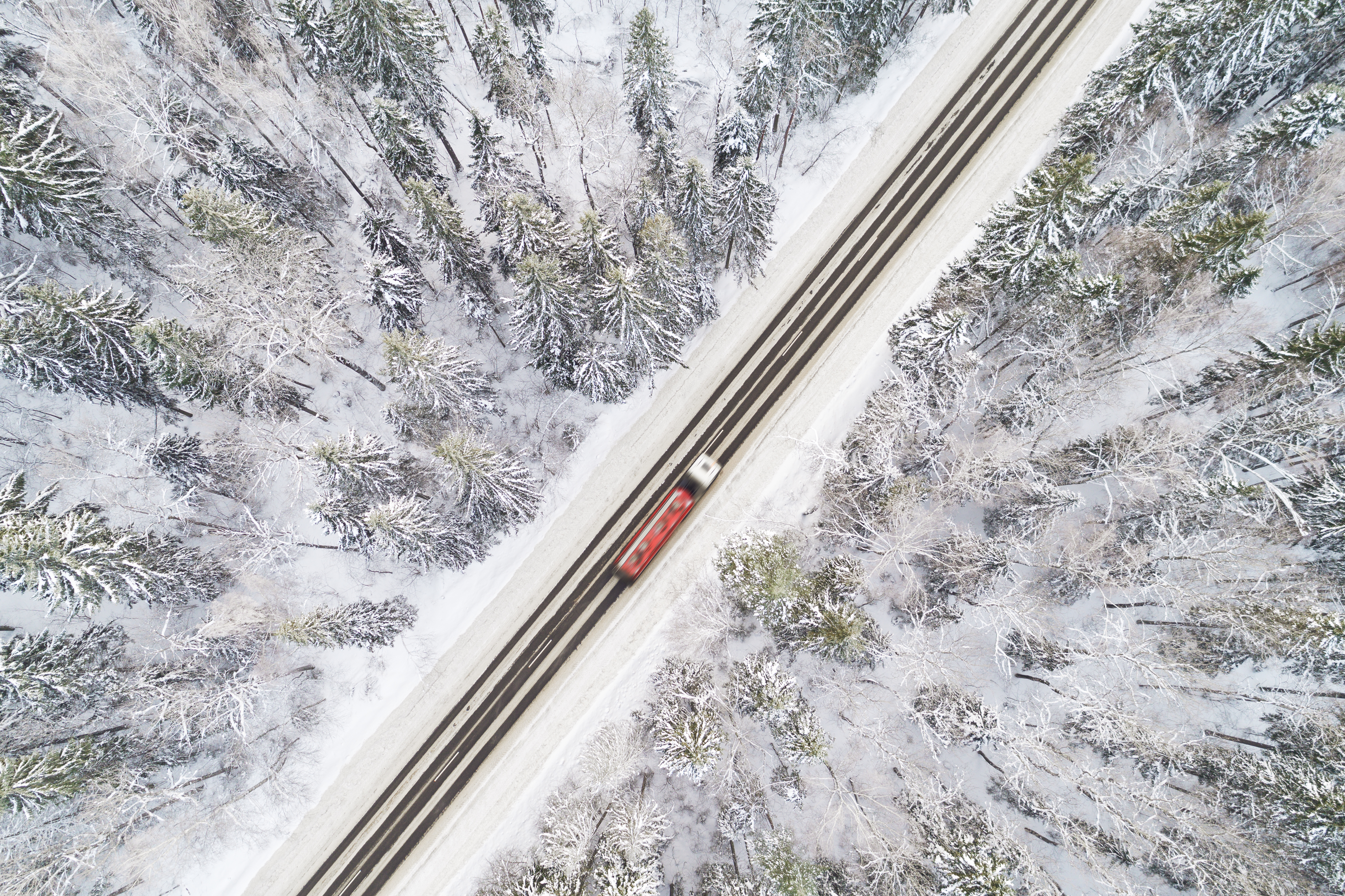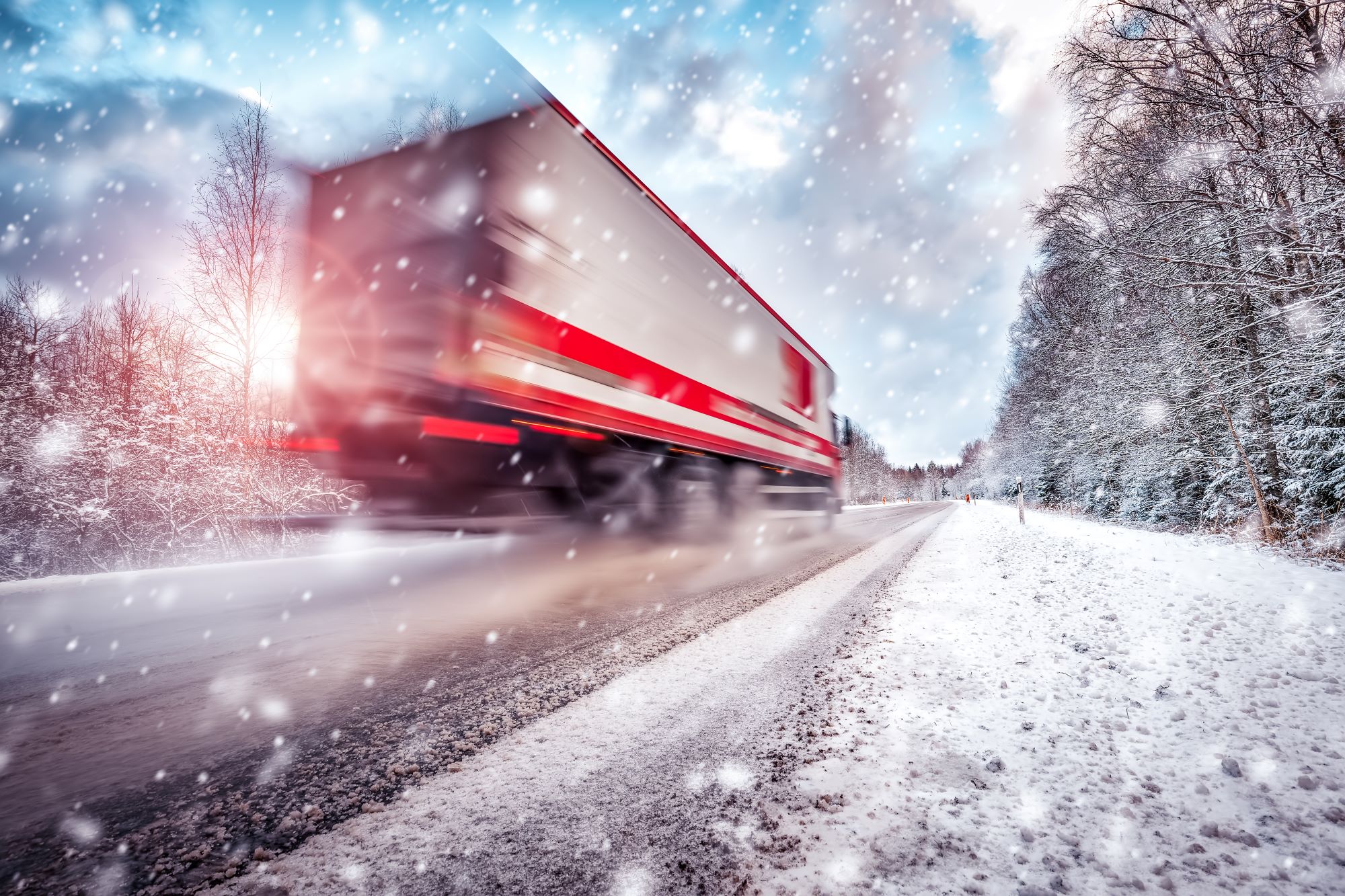
Miranda Blake
Пътеводител на шофьора на камион за зимата в Европа
Създаден: 16.10.2024
•
Актуализирано: 28.08.2025
Шофьорите на камиони са изправени пред уникални предизвикателства и отговорности през студените сезони. Наблюдава се рязко увеличение на тежките пътнотранспортни произшествия, като 33% от застрахователните искове, направени през този период, се считат за тежки.
И така, подготовката е от решаващо значение. Тук ви съветваме как водачите на камиони могат да останат в безопасност както на пътя, така и в кабината си тази зима.
Навигация при бурни условия
От ключово значение е да шофирате бавно и да спазвате безопасна дистанция от другите превозни средства - особено в наводнените райони. Трябва да включите камиона си на ниска предавка и да поддържате двигателя на високи обороти.
Следните съвети ще ви помогнат и при шофиране в бурно време.
- Ако изгубите контрол върху повърхността на водата, намалете скоростта, като отпуснете крака си от педала на газта - не се опитвайте да спирате или да завивате внезапно.
- По-високите превозни средства са по-уязвими при силен вятър - уверете се, че държите здраво кормилото и по възможност избягвайте мостовете.
- Пътувайте с отворени странични завеси, ако камионът ви е празен. По този начин има по-малко неща, които могат да бъдат уловени от вятъра.
Управление на снега и леда
При лед и сняг също трябва да се движите с намалена скорост и да спазвате необходимата дистанция от предния автомобил. Всъщност се препоръчва да увеличите спирачния път до 10 пъти над нормалния - това обаче може да е трудно да се прецени. Проучване на Admiral установи, че черният лед е причина за 10 % от произшествията през зимата. Можете да разберете дали шофирате върху черен лед, ако пътят изглежда мокър, но няма пръски от други превозни средства.
Други съвети, които могат да ви помогнат да шофирате в снега, включват редовни проверки на камиона и осигуряване на необходимото оборудване преди пътуването, като например кабели за скачане и инструменти за размразяване. Освен това, винаги бъдете наясно с предавката, на която трябва да сте, тъй като това може да ви спаси от загуба на контрол над камиона. На равни повърхности карайте на възможно най-високата предавка. Когато се спускате по наклон, използвайте моторната спирачка и се движете на ниски предавки. За да избегнете превъртане на колелата, използвайте по-висока предавка при потегляне - това ще ви осигури необходимото сцепление за придвижване на автомобила.

Осигуряване на видимост
С оглед на това, че опасните магистрали и външните фактори оказват негативно влияние върху зрението и причиняват произшествия с камиони, видимостта е от решаващо значение при всякакви метеорологични условия, особено когато е по-студено. Затова не забравяйте да проверите дали по предното ви стъкло няма стружки или пукнатини, тъй като през студените месеци те могат да се разпространят по-бързо.
Освен това искате да имате възможно най-добра видимост за светлините, регистрационния номер и предното стъкло. Освен почистването на снега и мръсотията е добре да миете редовно автомобила си, за да избегнете натрупването на пътна сол (тя предизвиква корозия).
Ако видимостта е лоша и условията станат опасни, най-добре е да се отклоните от пътя и да починете на най-близката спирка за камиони. Ако в крайна сметка се наложи да надвишите часовете за управление, тогава можете да използвате специално освобождаване за шофьори, които са попаднали в уникални обстоятелства, като например екстремни метеорологични събития.
Оценка на дълбочината на протектора на гумите
Ниските температури също могат да повлияят на функционалността на гумите, тъй като могат да доведат до намаляване на налягането на въздуха. А при износените гуми, които за съжаление увеличават спирачния път и намаляват нивото на стабилност на мокри и заледени пътища, този нисък протектор ще доведе до плъзгане.
В резултат на това е добре да проверявате дълбочината на протектора преди всяко пътуване в бурни и други тежки условия - по този начин ще сте наясно кога трябва да се справите с възникнали проблеми.
Спазване на правилата за зимни гуми
Изключително важно е да знаете и за различните разпоредби за зимните гуми. В някои страни шофьорите трябва да носят чували с пясък и лопати, а в други веригите за сняг са задължителни. Continental е изготвила просто ръководство за изискванията за зимни гуми за Великобритания и Европа.
От 1 ноември зимните гуми са задължителни в:
- Австрия
- Чешка република
- Финландия
- Франция
- Литва
- Сърбия
В други страни те са задължителни в края на месеца или през декември, или зависят от метеорологичните условия. Що се отнася до гумите с шипове, те са разрешени в изброените по-долу държави, но за тях има строги правила. Най-добре е да проверите правилата за всяка страна преди пътуването си.
- Австрия
- Беларус
- Дания
- Естония
- Финландия
- Франция
- Великобритания
- Латвия
- Лихтенщайн
- Литва
- Норвегия
- Испания
- Швеция
- Швейцария
- Турция
- Украйна
Носене на подходящи консумативи
Също така трябва да помислите как да се грижите за себе си през зимата. Това ще прозвучи очевидно, но се уверете, че имате достъп до достатъчно храна и напитки. Тъй като през студените сезони има по-голяма вероятност от затваряне на пътища, може да се окаже, че не винаги можете да стигнете до спирка за камиони. Подгответе се с възможности за закуска или храна, а в идеалния случай и с гореща напитка в шише.
Особено ако нямате достъп до място за почивка, се погрижете да останете на топло. Например вземете със себе си акумулаторни нагревателни пакети. По същия начин винаги имайте под ръка топли и резервни дрехи; това ще бъде особено полезно, ако дрехите изстинат и се намокрят при изпълнение на задачи, като например почистване на снега от предното стъкло.
В идеалния случай трябва да разполагате с комплект за оцеляване през зимата, който се състои от храна, напитки, преносимо зарядно устройство за телефон, фенерче, одеяла, жилетка с повишена видимост, лопата и здрави обувки за ходене.
Гарантиране на достъп до спирките за почивка с intruck
Въпреки че времето не зависи от вас, вие можете да защитите себе си и другите на пътя. Това включва да се уверите, че сте намерили безопасно и сигурно място за паркиране възможно най-скоро. Нашето приложение intruck или страница с карти ще ви покаже близките доставчици на услуги заедно с информация за съоръженията, които всеки от тях предлага.
Можете да изтеглите приложението intruck още днес, като кликнете върху тази връзка.



